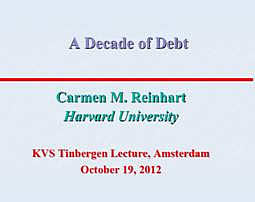
Prof. Reinhart delivered the lecture 'A Decade of Debt' by which she addressed the variations on debt themes such as debt overhang, deleveraging, unemployment and double dips in most advanced economies, the European risks from financial crash to debt crisis and more restructurings, the 'capital inflow problem' of the major emerging markets and a global issue of the return of financial repression. Countries have strong claims on other countries. Some of those claims are never refunded. That is annoying, unfair and unethical and that failure affects the bargaining power of the EU towards the Greeks. But that is not the fact on the table. Remission is the only option. The longer you wait, the more people moving away and the longer the investment in the deficit countries fails. And thus may ultimately be less refunded.
This pattern repeats itself from debt crisis: first, creditors want to know nothing of remission. But at some point, the ultimate question will come on the table: what do you want, little or nothing? Then the answer is almost always: now, give me but something.
